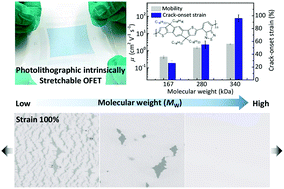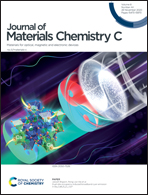Synchronously improved stretchability and mobility by tuning the molecular weight for intrinsically stretchable transistors†
Abstract
Commercial applications of skin-like electronic devices for healthcare, intelligent robotics and electronic communication require large-scale high-density transistor arrays with high mechanical deformability and robustness that can be provided by intrinsically stretchable transistors. However, the contradictory crystallinity-dominated mobility and stretchability in the currently reported polymer semiconductors result in extremely limited high-mobility intrinsically stretchable transistors. Herein, based on a polymer with strong intrachain transport, we pioneer the use of molecular weight modulation to synchronously achieve increased mobility from 0.56 to 1.95 cm2 V−1 s−1 and increased crack-onset strain from 26 to 97% in the PIDTBT film. Based on the molecular weight modulation, a high-performance intrinsically stretchable transistor array with stretchability up to 100 percent strain and mobility up to 1.84 cm2 V−1 s−1, was demonstrated. Moreover, the stretchable transistor array presents a device density as high as 375 devices per square centimeter and good electrical performance at the static and dynamic stretching strain. Our results provide a new strategy for creating intrinsically stretchable transistors with high mobility and present unprecedented opportunities for large-scale high-density production of next-generation stretchable electronics.



 Please wait while we load your content...
Please wait while we load your content...